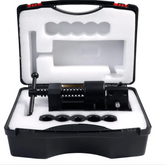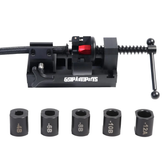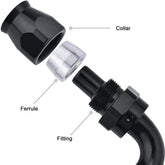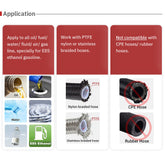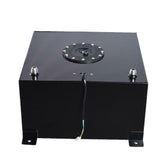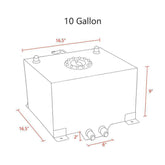If you search for '6.4 Power Stroke' in Google, you'll find that many owners of this engine have encountered issues related to performance and fuel economy. Removing components such as the exhaust gas recirculation (EGR) system and diesel particulate filter (DPF) can enhance your truck's horsepower and fuel efficiency, while also increasing the reliability of your engine.
While the DPF and EGR systems are designed to reduce emissions, they can also restrict airflow, leading to the buildup of harmful elements such as soot in your engine. Deleting these systems can reduce the strain on your engine, allowing it to operate more smoothly and achieve optimal performance. Discover the advantages and disadvantages of the 6.4 Ford Delete Kit.
Deleting 6.4 Powerstroke: Benefits and Drawbacks
The solution to maximizing the performance of your 6.4L Powerstroke engine might be to remove the EGR and DPF systems. These changes can have a number of advantages, such as increased fuel economy and longer engine life.
PERKS OF REMOVAL OF DPF
One item meant to lower emissions from diesel engines is the diesel particulate filter (DPF). But it can also lead to issues with your engine, such diluted oil and decreased airflow. There are a number of advantages to removing the DPF, including:
Extended Life of Engine:
The internal engine parts of your engine may experience wear as a result of oil dilution from the DPF. You may lessen this issue and prolong the life of your engine by removing the DPF.
Improved Exhaust Flow:
Airflow restriction by the DPF may result in hotter exhaust gases and delayed turbo spooling. Better performance can be achieved by removing this limitation, which will also lower exhaust gas temperatures and increase exhaust flow.
Enhanced Effectiveness
Your engine can run more smoothly without the DPF, which will boost horsepower and improve fuel economy.
Advantages of EGR Delete
Recirculating exhaust gas back into the engine is how the exhaust gas recirculation (EGR) system lowers emissions. But this can also lead to issues with your engine, such more wear and tear on the EGR cooler. There are various advantages to removing the EGR system, including:
Enhanced Fuel Economy:
You may cut pollutants and increase fuel economy by preventing hot exhaust fumes from entering the engine.
Longer Life of the EGR Cooler:
The EGR cooler's lifespan can be increased by lowering the possibility of cracks and other failures caused by the hot exhaust gasses not going through it.
Lower Chance of Engine Damage:
Engine damage that occurs too soon may be attributed to the EGR system. You can lower this danger and extend the engine's life by eliminating the EGR system.
DPF AND EGR REMOVAL'S CONS
Although removing the DPF and EGR can have many advantages, it's vital to remember that these changes are illegal in the US when used on public roads. It follows that you can only drive your truck off-road if you carry out these deletes.
Should You Delete Your DPF System?
Increased power, increased dependability, and better gas mileage all sound fantastic. The drawbacks, meanwhile, must not be ignored. If you're not going to push extreme power or your DPF has already failed, we really don't advise deleting your 6.4 Powerstroke DPF. In terms of performance, the DPF isn't all that restricting unless you are pushing extreme power.
Removing the particle filter is a hassle if your car doesn't have an improved turbo or a blocked DPF. In addition to potentially receiving a big fine, you won't pass emissions and some shops won't even touch your truck. Depending on the state you live in, you might even have your truck smashed.
We can appreciate the desire because the benefits to reliability and the gas savings are considerable. In the end, there is a trade-off between the benefits and the risks, and your risk tolerance will determine whether or not you should take the plunge.
How to Perform the Deletes?
It takes some expertise and the appropriate equipment to service your 6.4 Powerstroke delete engine's DPF and EGR. This is a step-by-step tutorial on how to execute the deletes.
- Gather Your Materials
Make sure you have all the supplies you'll need before you start. This contains a tuner, a DPF or EGR deletion kit, and additional required tools like a torque wrench or socket set.
- Remove the Old Components
You must first remove the outdated parts in order to remove the DPF or EGR system. Usually, the DPF delete entails taking off the old muffler and exhaust pipe and replacing them with the new parts. For the EGR delete, you will have to remove the cooler, EGR valve, and related piping.
- Install the New Components
It's time to install the new parts after removing the old ones. Installing the replacement exhaust pipe or EGR system block-off plate is usually required for this. Carefully follow the manufacturer's directions, and twist any bolts to the specified levels.
- Reprogram the Engine's Computer
You will need to use a tuner to reprogram the engine's computer in order to make sure the new parts fit and function properly. This enables you to enhance performance by adjusting parameters like air-to-fuel ratios and fuel injection time.
- Test the System
It is crucial to test the system after reprogramming the engine's computer and installing the new parts. To make sure everything is operating as it should, this may entail doing a test drive. On the dashboard, you can also look for any error codes or warning lights.
6.4 Powerstroke DPF Delete Summary
The DOC, DPF, and EGR are the three main emissions systems of the 6.4 Powerstroke. While the EGR is located within the engine, the DOC and DPF equipment is located within the exhaust system. The DOC is eliminated along with the DPF.
The 6.4 Powerstroke's DPF is prone to clogging, which compromises reliability. It also produces exhaust backpressure, which is detrimental to performance. As a result, clearing the DPF is common for reasons related to performance and dependability. Furthermore, on a healthy engine, it can boost gas mileage by 2-3 mpg, and on an engine with a clogged DPF, it can enhance mileage by up to 4-5 mpg.
There are drawbacks to removing the particle filter, though. It is harmful for the environment, will lower in value when resold, won't pass emissions, and if found, could result in large fines.

